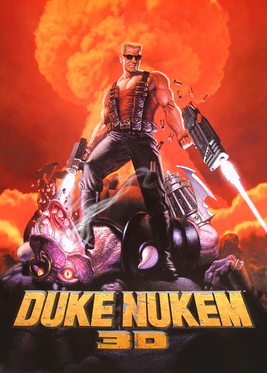
Doom is a first-person shooter game developed and published by id Software. Released on December 10, 1993, for DOS, it is the first installment in the Doom franchise. The player assumes the role of a space marine, later unofficially referred to as Doomguy, fighting through hordes of undead humans and invading demons. The game begins on the moons of Mars and finishes in hell, with the player traversing each level to find its exit or defeat its final boss. It is an early example of 3D graphics in video games, and has enemies and objects as 2D images, a technique sometimes referred to as 2.5D graphics.

Duke Nukem 3D is a first-person shooter video game developed by 3D Realms. It is a sequel to the platform games Duke Nukem and Duke Nukem II, published by 3D Realms.

id Software LLC is an American video game developer based in Richardson, Texas. It was founded on February 1, 1991, by four members of the computer company Softdisk: programmers John Carmack and John Romero, game designer Tom Hall, and artist Adrian Carmack.

Quake II is a 1997 first-person shooter video game developed by id Software and published by Activision. It is the second installment of the Quake series, following Quake. The game's storyline is continued in its expansions, including one tying in Quake II and the first game, and Quake 4.

Quake is a first-person shooter game developed by id Software and published by GT Interactive. The first game in the Quake series, it was originally released for MS-DOS, Microsoft Windows and Linux in 1996, followed by Mac OS and Sega Saturn in 1997 and Nintendo 64 in 1998. In the game, players must find their way through various maze-like, medieval environments while battling monsters using an array of weaponry. Quake takes inspiration from gothic fiction and the works of H. P. Lovecraft.

Rise of the Triad: Dark War is a first-person shooter video game, developed and published by Apogee Software in 1995. The player can choose one of five different characters to play as, each bearing unique attributes such as height, speed, and endurance. The game's story follows these five characters who have been sent to investigate a deadly cult, and soon become aware of a deadly plot to destroy a nearby city. Its remake was designed by Interceptor Entertainment and released by Apogee Games in 2013. The shareware version of the game is titled Rise of the Triad: The HUNT Begins.
Titan most often refers to:

Half-Life is a 1998 first-person shooter (FPS) game developed by Valve Corporation and published by Sierra Studios for Windows. It was Valve's debut product and the first game in the Half-Life series. The player assumes the role of Gordon Freeman, a scientist who must escape the Black Mesa Research Facility after it is invaded by aliens following a disastrous scientific experiment. The gameplay consists of combat, exploration and puzzles.

Doom II, also known as Doom II: Hell on Earth, is a first-person shooter game by id Software. It was released for MS-DOS in 1994 and Macintosh in 1995. Unlike the original Doom, which was initially only available through shareware and mail order, Doom II was sold in stores.

Half-Life: Opposing Force is an expansion pack for the first-person shooter game Half-Life. It was developed by Gearbox Software and published by Sierra On-Line for Windows on November 19, 1999. Opposing Force was the first expansion for Half-Life and was announced in April 1999. Lead designer Randy Pitchford noted that he believed Gearbox was selected to develop Opposing Force because Valve, the creators of Half-Life, wanted to concentrate on their future projects. Over the course of development, Gearbox brought in a variety of talent from other areas of the video games industry to help bolster various aspects of design.
Quake is a series of first-person shooter video games, developed by id Software and, as of 2010, published by Bethesda Softworks. The series is composed of Quake and its nonlinear, standalone sequels, which vary in setting and plot.
Doom WAD is the default format of package files for the video game Doom and its sequel Doom II: Hell on Earth, that contain sprites, levels, and game data. WAD stands for Where's All the Data? Immediately after its release in 1993, Doom attracted a sizeable following of players who created their own mods for WAD files—packages containing new levels or graphics—and played a vital part in spawning the mod-making culture which is now commonplace for first-person shooter games. Thousands of WADs have been created for Doom, ranging from single custom levels to full original games; most of these can be freely downloaded over the Internet. Several WADs have also been released commercially, and for some people the WAD-making hobby became a gateway to a professional career as a level designer.

Final Doom is a first-person shooter video game developed by TeamTNT, and Dario and Milo Casali, and was released by id Software and distributed by GT Interactive in 1996. It was released for MS-DOS and Macintosh computers, as well as for the PlayStation, although the latter featured a selection of levels from Final Doom and from Master Levels for Doom II.

Doom 64 is a first-person shooter game by Midway Games. It was first released for the Nintendo 64 in 1997, as the second spin-off game in the Doom series after Final Doom (1996), and the fourth game in the series overall. A remastered port was developed by Nightdive Studios and published by Bethesda Softworks for Nintendo Switch, PlayStation 4, Windows, and Xbox One in March 2020, and for Stadia in May 2020.

Walnut Creek CDROM Inc. was an early provider of freeware, shareware, and free software on CD-ROMs. The company was founded in by Bob Bruce in Walnut Creek, California, in August 1991. It was one of the first commercial distributors of free software on CD-ROMs. The company produced hundreds of titles on CD-ROMs, and ran the busiest FTP site on the Internet, ftp.cdrom.com, for many years.

Alien Breed 3D is a first-person shooter, the fourth game in Team17's Alien Breed franchise, a series of science fiction-themed shooters. It was published in 1995 by Ocean Software. It was followed by a sequel, Alien Breed 3D II: The Killing Grounds, in 1996.

id Tech is a series of separate game engines designed and developed by id Software. Prior to the presentation of the id Tech 5-based game Rage in 2011, the engines lacked official designation and as such were simply referred to as the Doom and Quake engines, from the name of the main game series the engines had been developed for. "id Tech" has been released as free software under the GNU General Public License. id Tech versions 0 to 3 were released under GPL-2.0-or-later. id Tech versions 3.5 to 4.5 were released under GPL-3.0-or-later. id Tech 5 to 7 are proprietary, with id Tech 7 currently being the latest utilized engine.

Doom is an American media franchise created by John Carmack, John Romero, Adrian Carmack, Kevin Cloud, and Tom Hall. The series usually focuses on the exploits of an unnamed space marine operating under the auspices of the Union Aerospace Corporation (UAC), who fights hordes of demons and the undead in order to save Earth from an apocalyptic invasion.

The Cyberdemon is a fictional character in the Doom video game franchise by id Software, where it was introduced in the first-person shooter game Doom in 1993. It has appeared in several other id games, including all main-line Doom sequels, Doom RPG, and Wolfenstein RPG as the Harbinger of Doom, along with other related media. The Cyberdemon became one of the most iconic characters of the Doom series along with its protagonist, the "Doomguy", and is often described as one of the most memorable bosses in video gaming history.
















